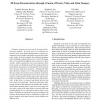Free Online Productivity Tools
i2Speak
i2Symbol
i2OCR
iTex2Img
iWeb2Print
iWeb2Shot
i2Type
iPdf2Split
iPdf2Merge
i2Bopomofo
i2Arabic
i2Style
i2Image
i2PDF
iLatex2Rtf
Sci2ools
122
click to vote
AIPR
2007
IEEE
2007
IEEE
3D Scene Reconstruction through a Fusion of Passive Video and Lidar Imagery
Geometric structure of a scene can be reconstructed using many methods. In recent years, two prominent approaches have been digital photogrammetric analysis using passive stereo imagery and feature extraction from lidar point clouds. In the first method, the traditional technique relies on finding common points in two or more 2D images that were acquired from different view perspectives. More recently, similar approaches have been proposed where stereo mosaics are built from aerial video using parallel ray interpolation, and surfaces are subsequently extracted from these mosaics using stereo geometry. Although the lidar data inherently contain 2.5 or 3 dimensional information, they also require processing to extract surfaces. In general, structure from stereo approaches work well when the scene surfaces are flat and have strong edges in the video frames. Lidar processing works well when the data is densely sampled. In this paper, we analyze and discuss the pros and cons of the two ...
AIPR 2007 | Lidar | LiDAR Data | LIDAR Point Clouds |
| Added | 02 Jun 2010 |
| Updated | 02 Jun 2010 |
| Type | Conference |
| Year | 2007 |
| Where | AIPR |
| Authors | Prudhvi Gurram, Stephen Lach, Eli Saber, Harvey E. Rhody, John P. Kerekes |
Comments (0)

